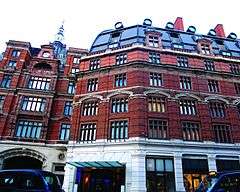Great Eastern Hotel, London
| Andaz London Liverpool Street | |
|---|---|
 | |
| Former names | Great Eastern Hotel |
| General information | |
| Location | Liverpool Street, London, England |
| Opening | 2007 |
| Owner | Hyatt Hotels Corporation |
| Design and construction | |
| Architect | Edward Middleton Barry, Charles Barry, Jr. |
| Other information | |
| Number of rooms | 267 |
| Number of suites | 15 |
| Number of restaurants | 5 |
| Website | |
| http://london.liverpoolstreet.andaz.hyatt.com | |
Andaz London Liverpool Street is a hotel in central London, situated immediately south of Liverpool Street station, which was built as the Great Eastern Hotel in 1884. The building underwent extensive renovation and expansion between 1899 and 1901,[1] and again in 2000, when it was co-owned by Terence Conran.[2] Hyatt has owned the hotel since 2006, operating it under their Andaz brand.
History
The hotel was designed by the brothers Charles Barry, Jr. and Edward Middleton Barry. An additional section, the Abercorn Rooms, was added a decade later by Robert William Edis.[3] The hotel's clientele included business people who could avoid City traffic by staying near the railway station.[4] A daily supply of fresh sea water for bathing was brought by train.[5] The building is notable also for its inclusion of two Masonic Temples—an Egyptian temple in the basement and a Grecian temple on the first floor.[3] Caledonian Lodge 134, a lodge of Scottish Masons, met at the Eastern from 1920 to 1947.[6]
By the second half of the twentieth century it was felt that the hotel was due for refurbishment, and, following the redesign and improvement of the station in the 1980s,[7] it was expected that an investor would be found to accomplish a similar task with the adjacent hotel. The Manser Practice, who had already achieved success by renovating the area at London Heathrow Airport, were awarded the refurbishment contract in 1996. They created a new lobby by removing several existing guest rooms, and increased the capacity to 267 rooms by reusing attic space.[1] Their design was informed by the practice of daylighting, which was realised by providing a lightwell in the ceiling of the lobby, one in the main dining room, and as many views of London as possible in the bedrooms.[8]
Since 2006 the hotel has been owned by Hyatt.[9] It operates as the Andaz London Liverpool Street, a 5 star boutique hotel.[10]
Facilities
The building (including the Abercorn Rooms) is built of red brick, "with stucco and stone ground floor and dressings in a mildly classical style".[1]Of the 267 rooms, 15 are suites. Seven bars and restaurants are available on property, as well as a fitness center and steam room.
In literature
The Great Eastern is where vampire hunter Abraham Van Helsing stays during his first visit to London in Bram Stoker's Gothic horror novel Dracula.[11] The narrator of W. G. Sebald's Austerlitz meets the titular character in the bar of the Great Eastern, after a two-decade separation; Austerlitz recounts details of the building including the Grecian temple.[12][13][14]
References
Notes
- 1 2 3 Riewoldt (2006), p. 112.
- ↑ Britten (2006), pp. 43–44.
- 1 2 Denby (1998), pp. 54–55.
- ↑ Porter & Prince (2008), p. 24.
- ↑ Tames (2006), p. 72.
- ↑ "Lane's Masonic Records 1717–1894". The Library and Museum of Freemasonry. Retrieved 11 April 2013.
- ↑ Sutcliffe (2006), p. 191.
- ↑ Phillips (2012), p. 102.
- ↑ Yue, Lorene (14 February 2006). "Global Hyatt is buying London's Great Eastern Hotel". Crain's Chicago Business. Retrieved 11 April 2013.
- ↑ Our 5 Star Boutique Hotel in London Andaz Hotels; accessed 2013.04.18.
- ↑ Ridenhour (2012), p. 171.
- ↑ Denham & McCulloh (2006), p. 297.
- ↑ Long (2007), p. 151.
- ↑ Smith, Charles Saumarez (29 September 2001). "Observer review: Austerlitz by W. G. Sebald". The Observer. Retrieved 11 April 2013.
Bibliography
- Britten, Fleur (2006). A Hedonist's Guide to London. A Hedonist's guide to London. ISBN 9781905428038.
- Denby, Elaine (1998). Grand Hotels: Reality and Illusion. Reaktion. ISBN 978-1-86189-121-1.
- Denham, Scott; McCulloh, Mark (2006). W. G. Sebald: History – Memory – Trauma. Walter de Gruyter. ISBN 978-3-11-020194-9.
- Long, J. J. (2007). W. G. Sebald: Image, Archive, Modernity. Columbia UP. ISBN 978-0-231-14512-1.
- Phillips, Derek (2012). Daylighting: Natural Light in Architecture. Routledge. ISBN 9781136412004.
- Porter, Darwin; Prince, Danforth (2008). Frommer's Portable London 2009. John Wiley & Sons. ISBN 9780470446669.
- Ridenhour, Jamieson (2012). In Darkest London: The Gothic Cityscape in Victorian Literature. Scarecrow. ISBN 978-0-8108-8778-7. Retrieved 11 April 2013.
- Riewoldt, Otto (2006). New Hotel Design. Laurence King. ISBN 978-1-85669-479-7. Retrieved 11 April 2013.
- Sutcliffe, Anthony (2006). London: An Architectural History. Yale UP. ISBN 978-0-30011-006-7.
- Tames, Richard (2006). London: A Cultural History. Oxford UP. ISBN 9780195309539.
External links
Coordinates: 51°31′02″N 0°04′52″W / 51.517251°N 0.081054°W